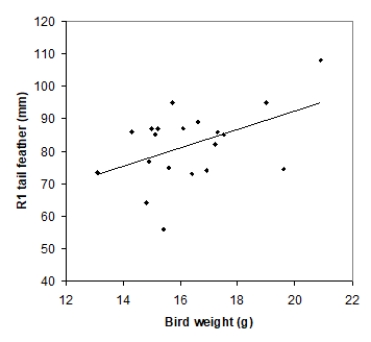Multiple Choice
Tail-feather length in birds is sometimes a sexually dimorphic trait; that is, the trait differs substantially for males and for females of the same species. Researchers studied the relationship between tail-feather length (measuring the R1 central tail feather) and weight in a sample of 20 male long-tailed finches raised in an aviary. The data are displayed in the scatterplot below, followed with software output about the least-squares regression model of feather length as a function of weight.
\begin{array}{l}\begin{array} { l l r } \hline &\text {Coefficients }&\text {Standard Error }\\\hline\text {Intercept }&35.7379 & 21.0523 \\\text { Bird-weight}&2.8299 & 1.2811\\\hline\text {R Square }&0.2133\\\text {Standard Error }&\ 10.5270\\end{array}\end{array} What does the standard error value of 10.5270 represent?
A) An estimate of the standard deviation σof the deviations about the mean in the linear regression model
B) The population standard deviationσ of the deviations about the mean in the linear regression model
C) The sample standard deviation of the feather lengths
D) The sample standard deviation of the feather lengths divided by √n
Correct Answer:

Verified
Correct Answer:
Verified
Q33: Before surgical removal of a diseased parathyroid
Q34: Data on the water quality in
Q35: Tail-feather length in birds is sometimes
Q36: The slope βof the population regression line
Q37: Researchers examined hormonal changes in 39
Q39: A fisheries biologist has been studying
Q40: Researchers want to know if reading
Q41: Tail-feather length in birds is sometimes
Q42: A researcher from the crop and
Q43: A random sample of 79 patients